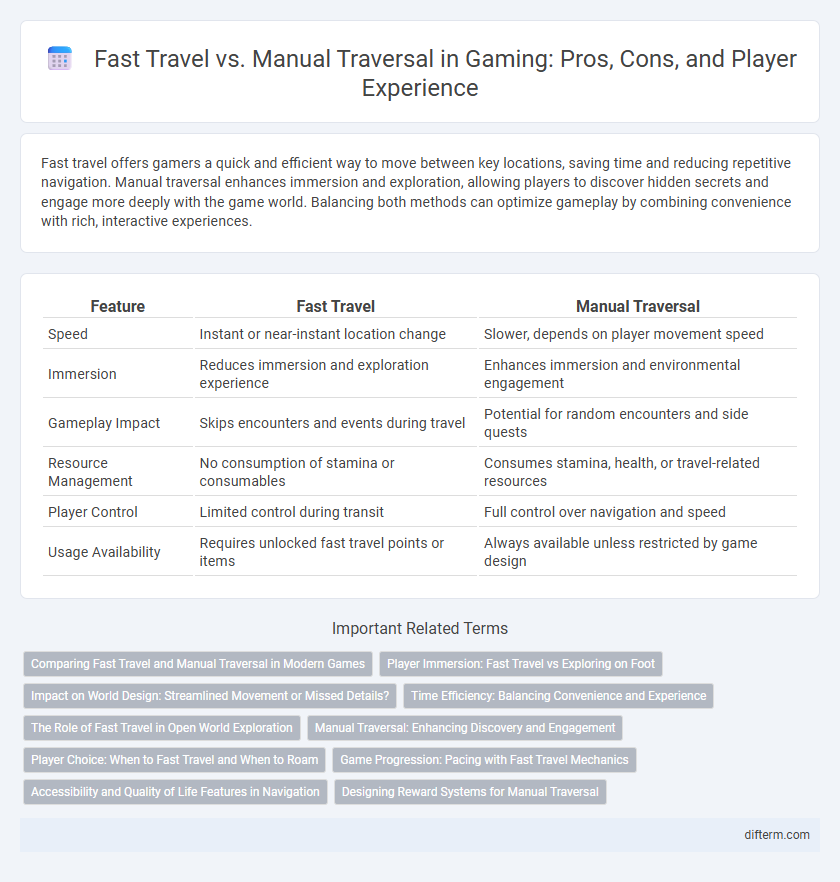Fast travel offers gamers a quick and efficient way to move between key locations, saving time and reducing repetitive navigation. Manual traversal enhances immersion and exploration, allowing players to discover hidden secrets and engage more deeply with the game world. Balancing both methods can optimize gameplay by combining convenience with rich, interactive experiences.
Table of Comparison
| Feature | Fast Travel | Manual Traversal |
|---|---|---|
| Speed | Instant or near-instant location change | Slower, depends on player movement speed |
| Immersion | Reduces immersion and exploration experience | Enhances immersion and environmental engagement |
| Gameplay Impact | Skips encounters and events during travel | Potential for random encounters and side quests |
| Resource Management | No consumption of stamina or consumables | Consumes stamina, health, or travel-related resources |
| Player Control | Limited control during transit | Full control over navigation and speed |
| Usage Availability | Requires unlocked fast travel points or items | Always available unless restricted by game design |
Comparing Fast Travel and Manual Traversal in Modern Games
Fast travel in modern games offers instant relocation, saving players significant time and reducing repetitive backtracking, enhancing overall gameplay efficiency. Manual traversal delivers immersive exploration, rewarding players with environmental storytelling, hidden secrets, and engagement through navigation challenges. Balancing fast travel and manual traversal allows developers to optimize player freedom while maintaining world-building depth and pacing.
Player Immersion: Fast Travel vs Exploring on Foot
Manual traversal enhances player immersion by encouraging exploration, discovery of hidden secrets, and interaction with the game world's environmental storytelling. Fast travel provides convenience and time-saving benefits but can disrupt the sense of presence and diminish emotional connection to the game's atmosphere. Balancing these options allows players to choose between immersive adventure and efficient navigation based on their playstyle preferences.
Impact on World Design: Streamlined Movement or Missed Details?
Fast travel in gaming enables streamlined movement by allowing players to bypass extensive manual traversal, which accelerates gameplay but can reduce exposure to immersive environmental storytelling and subtle world-building details. Manual traversal encourages exploration and interaction with intricate terrain, fostering deeper engagement with the game's ecosystem and narrative layers. Game designers must balance fast travel convenience against the opportunity cost of losing nuanced world design elements that enrich player experience.
Time Efficiency: Balancing Convenience and Experience
Fast travel significantly reduces in-game time spent moving between locations, allowing players to optimize their gaming sessions and focus on core objectives. Manual traversal enhances immersion and exploration, offering opportunities to discover hidden content and experience game environments more richly. Balancing fast travel with manual travel maintains time efficiency while preserving engaging gameplay and narrative depth.
The Role of Fast Travel in Open World Exploration
Fast travel enhances open world exploration by minimizing time spent on repetitive traversal, allowing players to focus on key objectives and discovery. Manual traversal encourages immersive engagement with the game environment, fostering organic encounters and deeper world-building appreciation. Balancing fast travel options with meaningful manual exploration enriches overall gameplay satisfaction and narrative immersion.
Manual Traversal: Enhancing Discovery and Engagement
Manual traversal in gaming fosters deeper player engagement by encouraging exploration of intricate environments, uncovering hidden secrets, and interacting with dynamic world elements. This hands-on approach enhances immersion, making discovery feel rewarding and personalized, which strengthens emotional connections to the game world. Games like The Elder Scrolls V: Skyrim and Red Dead Redemption 2 exemplify how manual traversal enriches storytelling and world-building through organic player-driven experiences.
Player Choice: When to Fast Travel and When to Roam
Fast travel offers rapid movement across vast gaming worlds, saving time but often missing dynamic encounters and environmental storytelling found during manual traversal. Players opting to roam manually can discover hidden quests, collectibles, and unexpected challenges, enriching immersion and gameplay variety. Strategic choice between fast travel and exploration empowers players to balance efficiency with deeper world engagement based on personal preference and objectives.
Game Progression: Pacing with Fast Travel Mechanics
Fast travel mechanics significantly influence game progression by allowing players to bypass repetitive or lengthy traversal, thus maintaining engagement and pacing. By reducing downtime spent on backtracking or crossing large maps, fast travel enables quicker access to key objectives and story-driven content. However, manual traversal encourages exploration and discovery, which can deepen immersion but may slow progression for players seeking a faster-paced experience.
Accessibility and Quality of Life Features in Navigation
Fast travel systems in gaming enhance accessibility by allowing players with limited mobility or time constraints to bypass lengthy manual traversal, reducing fatigue and frustration. Incorporating customizable markers, clear waypoint indicators, and contextual shortcuts further improves navigation quality of life by minimizing repetitive backtracking and confusion. Developers balancing fast travel with immersive manual exploration ensure inclusive gameplay experiences that cater to diverse player preferences and needs.
Designing Reward Systems for Manual Traversal
Designing reward systems for manual traversal emphasizes player engagement through immersive exploration and skill mastery, offering incentives like hidden collectibles, experience points, and unique achievements not accessible via fast travel. These rewards enhance the sense of adventure and encourage players to interact deeply with game environments, fostering a richer gameplay experience. Balancing risk and reward during manual traversal motivates players to invest time and effort, amplifying satisfaction and retention in open-world gaming.
fast travel vs manual traversal Infographic

 difterm.com
difterm.com